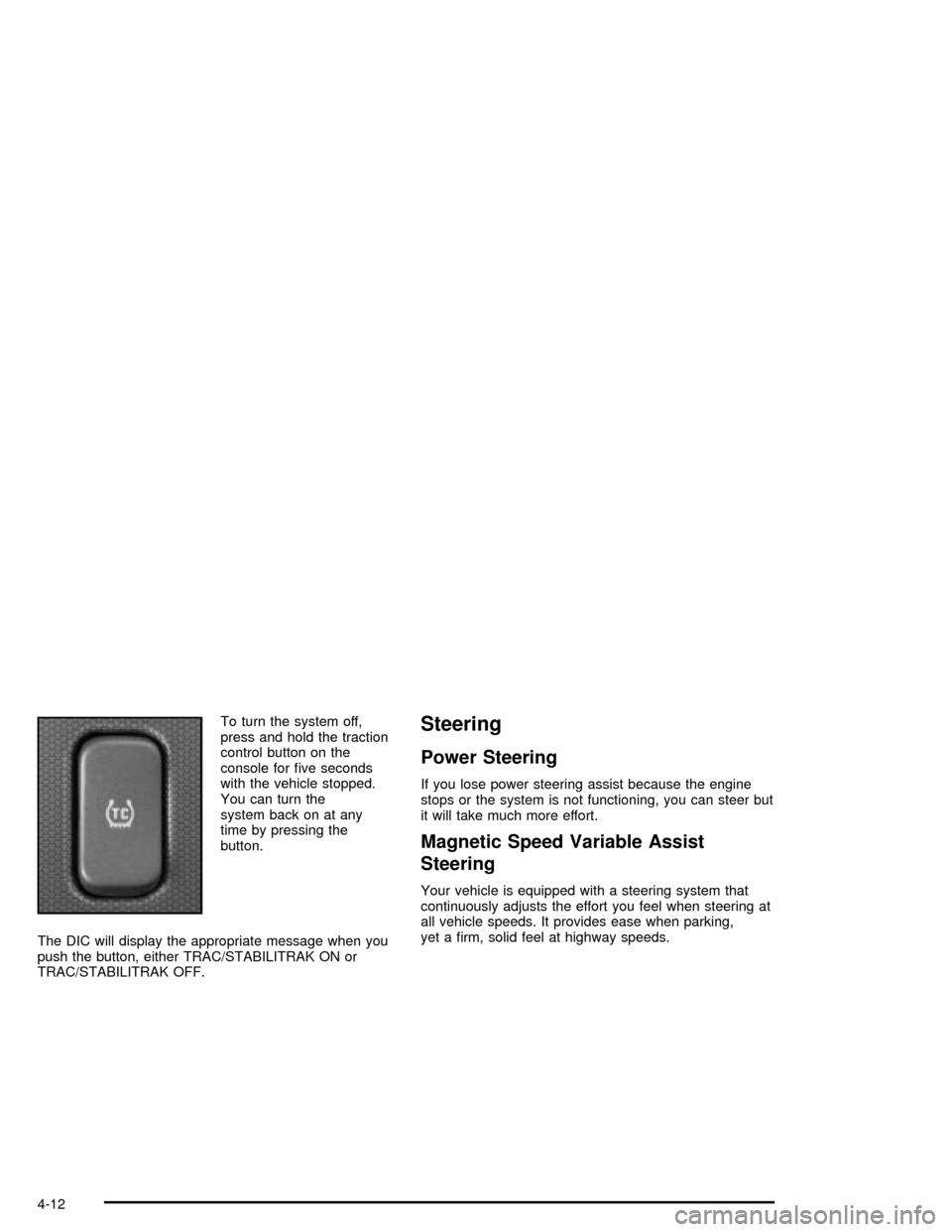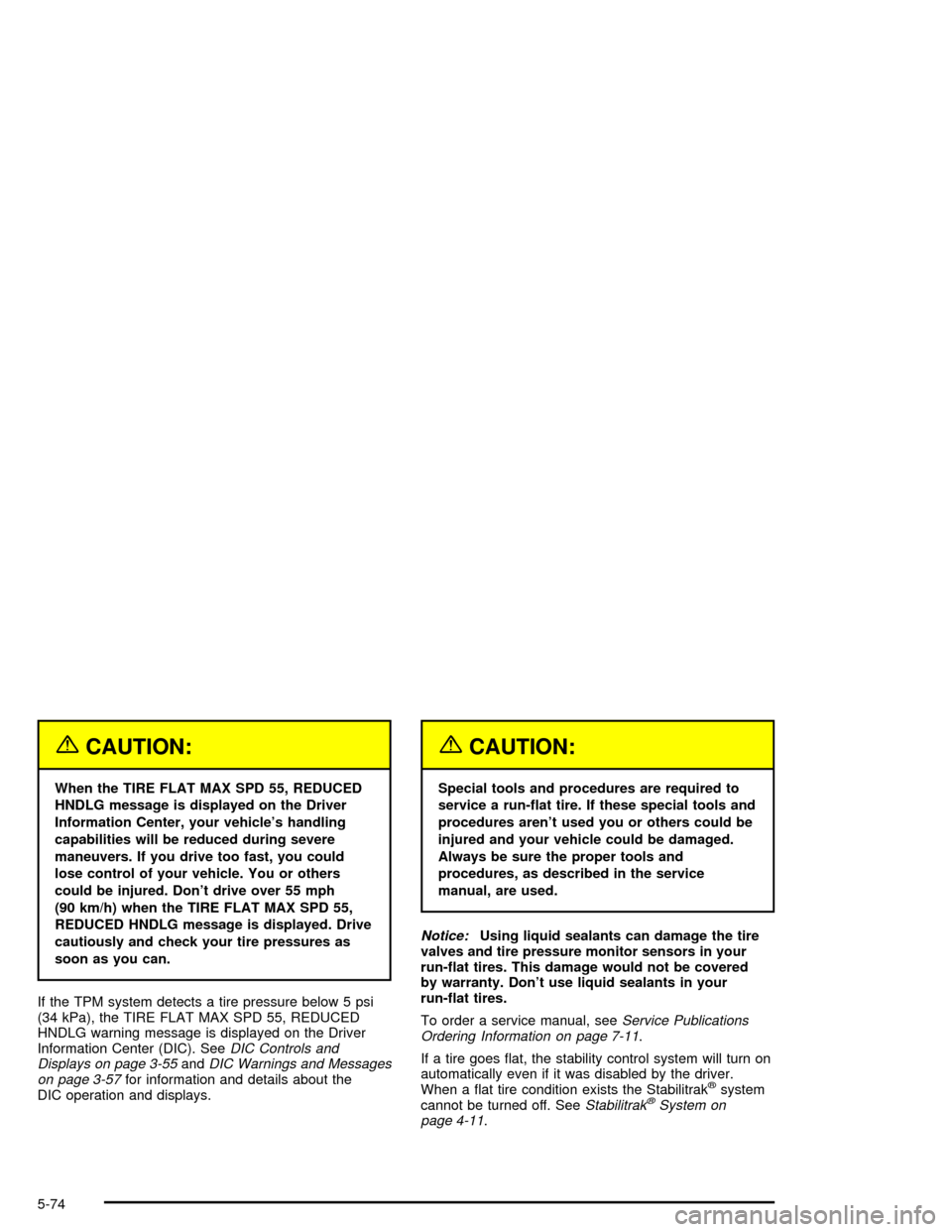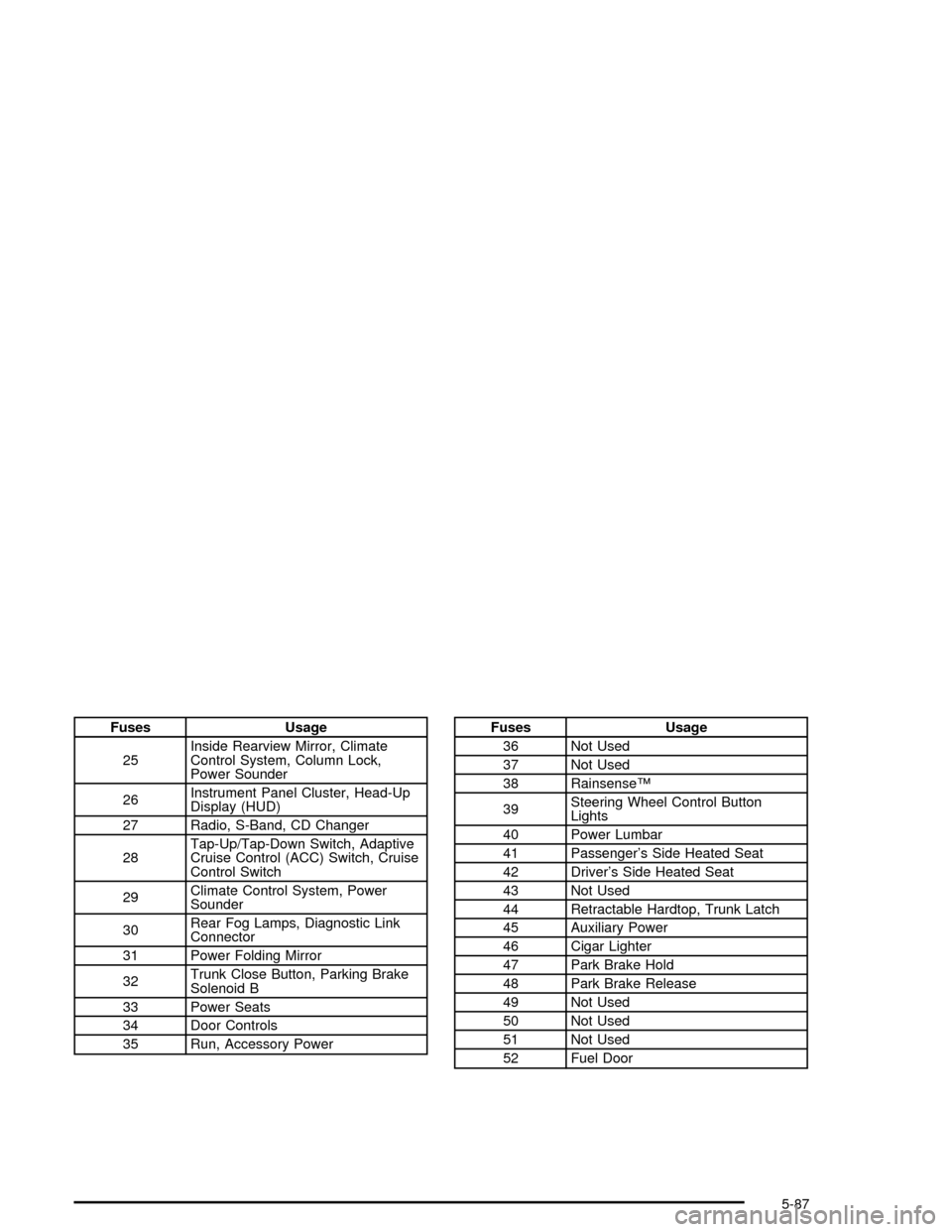display CADILLAC XLR 2004 1.G Workshop Manual
[x] Cancel search | Manufacturer: CADILLAC, Model Year: 2004, Model line: XLR, Model: CADILLAC XLR 2004 1.GPages: 356, PDF Size: 2.36 MB
Page 196 of 356

To turn the system off,
press and hold the traction
control button on the
console for ®ve seconds
with the vehicle stopped.
You can turn the
system back on at any
time by pressing the
button.
The DIC will display the appropriate message when you
push the button, either TRAC/STABILITRAK ON or
TRAC/STABILITRAK OFF.Steering
Power Steering
If you lose power steering assist because the engine
stops or the system is not functioning, you can steer but
it will take much more effort.
Magnetic Speed Variable Assist
Steering
Your vehicle is equipped with a steering system that
continuously adjusts the effort you feel when steering at
all vehicle speeds. It provides ease when parking,
yet a ®rm, solid feel at highway speeds.
4-12
Page 245 of 356

Coolant Surge Tank Pressure Cap
Notice:If the pressure cap is not tightly installed,
coolant loss and possible engine damage may
occur. Be sure the cap is properly and tightly
secured.
See
Engine Compartment Overview on page 5-12for
information on location.
Engine Overheating
You will ®nd an COOLANT OVER TEMP message or
an ENGINE HOT, STOP ENGINE message displayed in
the Driver Information Center (DIC). You will also
hear a chime. There is also an engine coolant
temperature gage on the instrument panel cluster. See
Engine Coolant Temperature Gage on page 3-47.
Overheated Engine Protection
Operating Mode
This operating mode allows your vehicle to be driven to
a safe place in an emergency situation. If an overheated
engine condition exists and the DIC message ENGINE
HOT, STOP ENGINE is displayed, an overheat
protection mode which alternates ®ring groups of
cylinders helps prevent engine damage. In this mode,
you will notice a signi®cant loss in power and engine
performance. Driving extended miles (km) in the
overheat protection mode should be avoided.
Notice:After driving in the overheated engine
protection operating mode, to avoid engine damage,
allow the engine to cool before attempting any
repair. The engine oil will be severely degraded.
Repair the cause of coolant loss, change the oil and
reset the oil life system. See
Engine Oil on
page 5-13.
5-23
Page 256 of 356

Adding Washer Fluid
The LOW WASHER FLUID message will be displayed
on the Driver Information Center (DIC) when the
¯uid is low.
The windshield washer
¯uid reservoir is located in
front of the underhood
fuse block on the driver's
side of the vehicle.
Open the cap with the washer symbol on it. Add washer
¯uid until the tank is full.
Notice:
·When using concentrated washer ¯uid, follow
the manufacturer's instructions for adding
water.
·Do not mix water with ready-to-use washer ¯uid.
Water can cause the solution to freeze and
damage your washer ¯uid tank and other parts
of the washer system. Also, water does not
clean as well as washer ¯uid.
·Fill your washer ¯uid tank only three-quarters
full when it is very cold. This allows for
expansion if freezing occurs, which could
damage the tank if it is completely full.
·Do not use engine coolant (antifreeze) in your
windshield washer. It can damage your washer
system and paint.
5-34
Page 280 of 356

When to Check
Check your tires once a month or more.
How to Check
Use a good quality pocket-type gage to check tire
pressure. You can't tell if your tires are properly in¯ated
simply by looking at them. Radial tires may look
properly in¯ated even when they're underin¯ated. Check
tire in¯ation pressure when the tire is cold. Cold
means your vehicle has been sitting for at least three
hours or driven no more than 1 mile (1.6 km).
Remove the valve cap from the tire valve stem. Press
the tire gage ®rmly onto the valve to get a pressure
measurement. If the cold tire in¯ation pressure matches
the recommended pressure on the Tire and Loading
Information label, no further adjustment is necessary.
If the in¯ation pressure is low, add air until you reach the
recommended amount.
If you over®ll the tire, release air by pushing on the
metal stem in the center of the tire valve. Recheck the
tire pressure with the tire gage.
Be sure to put the valve caps back on the valve stems.
They help prevent leaks by keeping out dirt and
moisture.
Tire Pressure Monitor (TPM)
Your vehicle has a Tire Pressure Monitor (TPM) that
sends tire pressure information to the Driver Information
Center (DIC). Using the DIC control buttons, the
driver is able to check tire pressure levels in all four
road tires. See
Tire Pressure Monitor System on
page 5-58andDIC Controls and Displays on page 3-55for additional information.
Tire Pressure Monitor System
The Tire Pressure Monitor (TPM) System on your
vehicle, uses radio and sensor technology to check tire
pressure levels. Sensors, mounted on each tire and
wheel assembly transmit tire pressure readings to
a receiver located in the vehicle. The TPM sensors
transmit tire pressure readings once every 60 seconds
while the vehicle is being driven and once every
60 minutes when the vehicle is stationary for more than
15 minutes. Using the Driver Information Center
(DIC), tire pressure levels can be viewed by the driver.
The TPM system also uses the DIC to warn the
driver when air pressure, in one or more tires, falls
below 25 psi (172 kPa) or is above 38 psi (262 kPa).
For additional information and details about the
DIC operation and displays see
DIC Controls and
Displays on page 3-55andDIC Warnings and Messages
on page 3-57.
5-58
Page 281 of 356

A low tire warning light also appears on the instrument
panel cluster when a low tire condition exists. The
DIC message, CHECK TIRE PRESSURE and the low
tire pressure warning light will be shown each time
the engine is started and stay on until the low tire
condition is corrected.
When the tire pressure
monitoring system warning
light is lit, one or more
of your tires is signi®cantly
under-in¯ated.
You should stop and check your tires as soon as
possible, and in¯ate them to the proper pressure as
indicated on the vehicle's tire information placard.
Driving on a signi®cantly under-in¯ated tire causes the
tire to overheat and can lead to tire failure.
Under-in¯ation also reduces fuel efficiency and tire tread
life, and may affect the vehicle's handling and stopping
ability. Each tire, including the spare, should be
checked monthly when cold and set to the
recommended in¯ation pressure as speci®ed in the
vehicle placard and owner's manual.The Tire and Loading Information Label (tire information
placard) is either on the rear edge of the driver's door
or the driver's door jamb near the latch. This label shows
the size of your vehicle's original tires and the correct
in¯ation pressure for your vehicle's tires when they
are cold. See
In¯ation - Tire Pressure on page 5-57.
Your vehicle's TPM system can alert you about a low or
high tire pressure condition but it does not replace
normal tire maintenance. See
Tire Inspection and
Rotation on page 5-60
Each TPM sensor has a unique identi®cation code that
is matched to one of the four tire positions on your
vehicle. The tire and wheel assembly positions are, left
front (LF); right front (RF); right rear (RR) and left
rear (LR). Any time you rotate your vehicle's tires or
replace one or more TPM sensors, the identi®cation
codes will need to be matched to the new tire and wheel
position. The TPM matching process is performed in
a speci®c sequence and time limit. A special tool is also
required. See your dealer for service.
The SVC TIRE MONITOR message is displayed when
the TPM system is malfunctioning. For example,
one or more TPM sensors may be inoperable or
missing. See your dealer for service.
5-59
Page 296 of 356

{CAUTION:
When the TIRE FLAT MAX SPD 55, REDUCED
HNDLG message is displayed on the Driver
Information Center, your vehicle's handling
capabilities will be reduced during severe
maneuvers. If you drive too fast, you could
lose control of your vehicle. You or others
could be injured. Don't drive over 55 mph
(90 km/h) when the TIRE FLAT MAX SPD 55,
REDUCED HNDLG message is displayed. Drive
cautiously and check your tire pressures as
soon as you can.
If the TPM system detects a tire pressure below 5 psi
(34 kPa), the TIRE FLAT MAX SPD 55, REDUCED
HNDLG warning message is displayed on the Driver
Information Center (DIC). See
DIC Controls and
Displays on page 3-55andDIC Warnings and Messages
on page 3-57for information and details about the
DIC operation and displays.
{CAUTION:
Special tools and procedures are required to
service a run-¯at tire. If these special tools and
procedures aren't used you or others could be
injured and your vehicle could be damaged.
Always be sure the proper tools and
procedures, as described in the service
manual, are used.
Notice:Using liquid sealants can damage the tire
valves and tire pressure monitor sensors in your
run-¯at tires. This damage would not be covered
by warranty. Don't use liquid sealants in your
run-¯at tires.
To order a service manual, see
Service Publications
Ordering Information on page 7-11.
If a tire goes ¯at, the stability control system will turn on
automatically even if it was disabled by the driver.
When a ¯at tire condition exists the Stabilitrak
žsystem
cannot be turned off. SeeStabilitrakžSystem on
page 4-11.
5-74
Page 309 of 356

Fuses Usage
25Inside Rearview Mirror, Climate
Control System, Column Lock,
Power Sounder
26Instrument Panel Cluster, Head-Up
Display (HUD)
27 Radio, S-Band, CD Changer
28Tap-Up/Tap-Down Switch, Adaptive
Cruise Control (ACC) Switch, Cruise
Control Switch
29Climate Control System, Power
Sounder
30Rear Fog Lamps, Diagnostic Link
Connector
31 Power Folding Mirror
32Trunk Close Button, Parking Brake
Solenoid B
33 Power Seats
34 Door Controls
35 Run, Accessory PowerFuses Usage
36 Not Used
37 Not Used
38 RainsenseŸ
39Steering Wheel Control Button
Lights
40 Power Lumbar
41 Passenger's Side Heated Seat
42 Driver's Side Heated Seat
43 Not Used
44 Retractable Hardtop, Trunk Latch
45 Auxiliary Power
46 Cigar Lighter
47 Park Brake Hold
48 Park Brake Release
49 Not Used
50 Not Used
51 Not Used
52 Fuel Door
5-87
Page 346 of 356

Doing Your Own Service Work........................... 5-4
Door
Locks.......................................................... 2-8
Power Door Locks.......................................2-10
Programmable Automatic Door Locks.............2-10
Driver
Position, Safety Belt.....................................1-10
Driver Information Center (DIC).........................3-55
DIC Controls and Displays............................3-55
DIC Vehicle Personalization..........................3-66
DIC Warnings and Messages........................3-57
Other Messages..........................................3-65
Driver Shift Control.........................................2-25
Driving
At Night.....................................................4-18
City...........................................................4-23
Defensive..................................................... 4-2
Drunken....................................................... 4-2
Freeway.....................................................4-24
Hill and Mountain Roads..............................4-26
In Rain and on Wet Roads...........................4-20
Winter........................................................4-28
Driving On Snow or Ice...................................4-29
Driving Through Deep Standing Water...............4-22
Driving Through Flowing Water.........................4-22
Dual Climate Control System............................3-33E
Eight-Way Power Seats..................................... 1-2
Electrical System
Add-On Equipment......................................5-84
Fuses and Circuit Breakers...........................5-85
Power Windows and Other Power Options......5-84
Windshield Wiper Fuses...............................5-84
Emergency Trunk Release Handle.....................2-14
Emissions Inspection and Maintenance
Programs...................................................3-51
Engine
Air Cleaner/Filter.........................................5-18
Battery.......................................................5-38
Check and Service Engine Soon Light............3-48
Coolant......................................................5-20
Coolant Heater............................................2-21
Coolant Temperature Gage...........................3-47
Drive Belt Routing.......................................6-13
Engine Compartment Overview......................5-12
Exhaust.....................................................2-31
Oil .............................................................5-13
Oil Pressure Gage.......................................3-52
Overheating................................................5-23
Starting......................................................2-20
Engine Oil Additives........................................5-16
4
Page 348 of 356

Gasoline
Octane........................................................ 5-5
Speci®cations............................................... 5-5
Gate Operator and Canadian Programming........2-39
Glove Box.....................................................2-41
GM Mobility Program for Persons with
Disabilities.................................................... 7-5
H
Hazard Warning Flashers................................... 3-4
Headlamp
Aiming.......................................................5-46
Vertical Aiming............................................5-47
Headlamp High/Low-Beam Changer.................... 3-6
Headlamps
Bulb Replacement.......................................5-49
Headlamps on Reminder................................... 3-6
Head-Up Display (HUD)...................................3-27
Heated Seats................................................... 1-3
Highway Hypnosis...........................................4-26
Hill and Mountain Roads..................................4-26
HomeLink
žTransmitter....................................2-37
HomeLinkžTransmitter, Programming................2-37
Hood
Checking Things Under................................5-10
Release.....................................................5-11
Horn............................................................... 3-5How the System Works...................................3-31
How to Add Coolant to the Coolant
Surge Tank.................................................5-28
How to Check........................................5-19, 5-58
How to Check Lubricant...................................5-45
How to Check Power Steering Fluid..................5-33
How to Remove and Replace the Floor Mats......2-42
How to Use This Manual...................................... ii
How to Wear Safety Belts Properly..................... 1-9
Hydroplaning..................................................4-21
I
If No Steam Is Coming From Your Engine..........5-25
If Steam Is Coming From Your Engine...............5-24
If the Light Is Flashing.....................................3-49
If the Light Is On Steady.................................3-50
If You Are Caught in a Blizzard.........................4-30
If You Are Stuck in Sand, Mud, Ice or Snow.......4-31
Ignition Positions.............................................2-19
Infants and Young Children, Restraints...............1-20
In¯ation - Tire Pressure...................................5-57
Instrument Panel
Cluster.......................................................3-40
Overview..................................................... 3-2
Instrument Panel Brightness.............................3-25
Instrument Panel Fuse Block............................5-85
Interior Lamps................................................3-25
6